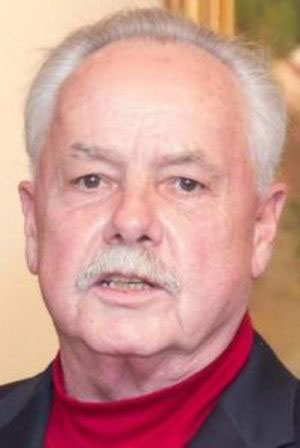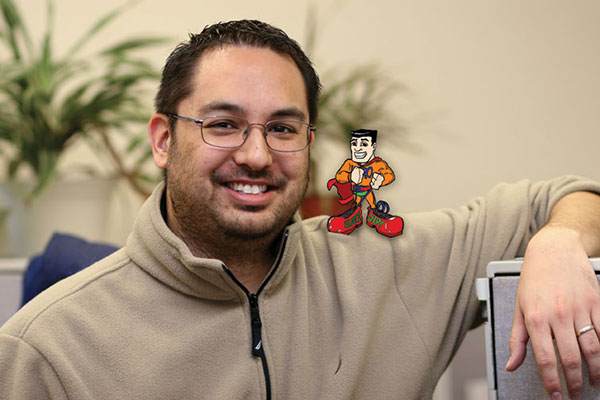
Pat East, founder of Hanapin Marketing and an investor in local tech start-ups, mentors local entrepreneurs to help them avoid the pitfalls he encountered along the road to success. | Courtesy photo
Tech innovator and angel investor Pat East was chatting with his six-year-old daughter not long ago.
The conversation turned to what she would be when she grows up. East asked: “Are you going to start your own business like Mommy and Daddy did?”
“Why,” she replied instantly, curling her lip, “would I do that?”
Why, indeed. Starting a business can be the ordeal of a lifetime, even if the operation somehow becomes a success. East and his wife, Jamie, started their own internet advertising and marketing agency some 14 years ago. Now Hanapin Marketing is a multimillion-dollar concern, boasting clients like Home Depot, the University of Chicago, Icelandair, the Weather Channel, and even NPR. The business, employing some 75 people both locally and remotely across the nation, virtually runs itself, allowing East to pursue other passions.
That doesn’t mean success came easily or without heartache. Those hardships, those heartbreaks, are what East hopes to help other dreamers, other entrepreneurs, avoid — or, if they can’t completely dodge adversities, at least they can weather them with his assistance.
So now chief among East’s passions is helping develop support organizations and companies like Dimension Mill, VisionTech Angels, and the Bloomington Technology Partnership. They all, he hopes, make Bloomington a dynamic, if cozy, Midwest center for tech innovation and a recognized start-up incubator.
This town already is gaining a rep as the place to be in these parts if an entrepreneur hopes to found an internet or IT business. “Bloomington is definitely an emerging center of technology and innovation,” East says. “It’s because of Indiana University. It’s because our quality of life here is great. Bloomington attracts a person who, quite frankly, is intelligent. We have one of the highest rates in the nation, per capita, of advanced degrees. We’re able to start great companies because of all of the pure, raw intelligence Bloomington has. Companies can hire lots of great employees who have high IQs and emotional quotients. They can figure stuff out on their own without having to be taught exactly how to do it.”

Tim Jacobs, founder of First Book Library, a self-publishing company that eventually became Author Solutions. | Courtesy photo
East and his wife, Jamie East, started Hanapin Marketing in 2004 with little more than an idea and a small personal computer. “I started Hanapin out of a spare bedroom in our house,” East says. He’d been working for another dreamer, another entrepreneur, Tim Jacobs, who’d started First Book Library, the company that eventually became Author Solutions, a Bloomington print-on-demand, self-publishing house. East went to work for that company straight out of school where, he claims, he was “the worst English major in the history of Wabash College.”
As he tells it, East declared English as his major after hunting around for a discipline for the first year and a half of his Wabash term. When he took his senior comprehensive exams, he failed not once but twice. Says he: No other Wabash English major had ever pulled off that double play. He eventually passed those exams, but don’t let the anecdote fool you — he’d finished in the top ten in his high school graduating class. He has grown into a thoughtful, well-spoken man.
Jacobs also was a Wabash alum. He hired East to help do author promotions for his company in 2000 when it was still First Books Library. East’s role within the company expanded rapidly until he became its corporate marketer. First Books generated business by purchasing mailing lists from the likes of Writers Digest magazine and then approaching potential clients through direct mail appeals, now a quaint, old-school marketing method. But as East started handling the company’s overall marketing, a new formula called pay-per-click was emerging.
“Right around 2001, 2002, the Post Office increased our rates twice in one year,” East says. “I did the math and told Tim, ‘Hey, if the Post Office continues to do this twice every year or even once every two years, eventually the economics of this won’t make sense. This is not a good road for us to go down.’”

East in the early days of Hanapin Marketing, circa 2009, in “Wabash Magazine.” | Courtesy photo
The new road led them to the internet. The two looked into pay-per-click (PPC) advertising, then a fairly new model that would soon be adopted by the biggest, most successful internet titans. Using PPC technology, advertisers pay agencies for every potential customer who clicks into their websites directly from their ads. The trick is to get the most-promising customers to look at the ads and act.
“We did our research and decided to try our hand at pay-per-click advertising,” East says. “We spent two or three days trying to come up with the right keyword. Within the first month, we quintupled our number of leads. That’s how the company grew from around 40 employees to 200, from $6 million in revenue to $20 million in four years.” In 2007, First Books became Author Solutions.
Jacobs must have swooned over Pat East. “He and I are still good friends,” East says. “Right around 2003, 2004, Google was getting ready to launch its IPO, and I thought, ‘If I can’t figure out a way to ride this wave, I’m going to regret it.” At the same time, East was sharing with his wife the usual wage-slave’s dream about one day becoming his own boss.
“For our anniversary, my wife gave me a $2,000 laptop,” East says. “She said, ‘You can do this work on your own!’ At the time — and, really, now — all you needed was a laptop and an internet connection to start a tech business.
“I gave notice on a Monday. The boss comes into my office on Tuesday, and says, ‘How would you like for us to be your first client?’ They’ve been our client for 14 years.”
East had to trek up to Indianapolis to make connections, meet other entrepreneurs face-to-face, and find resources for his start-up. Then there were the inevitable bumps in the road. More accurately, deep potholes.

East and his wife, Jamie, co-founders of Hanapin Marketing. | Courtesy photo
“At one point, the company was me and five other people. We had just lost a quarter of a million dollars worth of annual business, 25 percent of our revenue! That was pretty dramatic. I gathered everybody in the office, and said, ‘Let’s figure this out. Let’s make sure there’s not going to be another shoe that drops.’ Everybody just shrugged their shoulders. Nobody had any idea why it happened.”
East and company survived that near-shipwreck. CEOs don’t always have all the answers. Sometimes, though, all they need is a sympathetic ear, someone who’s been on those rough seas.
“In the beginning, I had to go up to Indianapolis to get the resources and a lot of the mentorship I needed. I realized then, starting and building a business should be a lot easier. I began to want to make it easier for founders and entrepreneurs to build their own companies and get their resources here in Bloomington,” East says.
That’s why, now, East’s days are spent working with all those new and emerging tech and innovation-support organizations. The Bloomington Technology Partnership is public-private nonprofit funded by the city and IU, as well as the Bloomington Economic Development Corporation, to foster this town’s high tech economy. East serves on its executive advisory committee.
VisionTech Angels is the investors’ arm of VisionTech Partners, an Indy-based consortium of entrepreneurs, inventors, investors, and others looking to nurture new tech companies. East is the Angels’ Bloomington chapter president.
Dimension Mill is a 19,000-square-foot co-working, incubator space, scheduled to open this fall in one of the buildings in the old Showers factory complex.
East is a leader among the already successful tech innovators who want to share their good fortune. “These folks are all interested in growth,” he says. “All of these different organizations help fuel growth in some way. Our mission is to launch and accelerate companies and eventually become a center of gravity for technology and innovation and entrepreneurship here in Indiana.”

The groundbreaking ceremony on March 6 for the first phase of the Dimension Mill and Trades District; the original Dimension Mill is the building to the far right in the background. Breaking ground (l-r) are: Don Griffin, president, Bloomington Redevelopment Commission; Pat East; Craig McCormick, principal, Blackline Studio; Jane Martin, board president, Dimension Mill, Inc.; Mayor John Hamilton; Alex Crowley, director, Economic and Sustainable Development, City of Bloomington; and Jon Bohlander, principal, Anderson Bohlander. | Limestone Post
You might think successful companies wouldn’t care much to give a leg up to new, potential competitors. Not so, says East. “While I may not compete with a company like Periodic, who does online scheduling, or Cheddar, who does online billing, we do compete for a lot of the same employees,” he explains. “Employees aren’t going to want to live in Bloomington if there’s not a lot of good choices to select from. If it’s only Hanapin Marketing, I may get my pick of the folks who want to live in Bloomington, but there wouldn’t be a lot of folks who want to live in Bloomington if they can only work for one company. Having competition is definitely good for everybody. It keeps everybody on their toes. It creates growth and growth creates opportunities.”
Funny thing is, East doesn’t look much like the stereotype of the successful, civic-minded businessman. He sports a lush beard. He wears T-shirts and sweatshirts. He more shambles than strides boldly into the conference room. It’s a well-thought-out look.

Hanapin Marketing “virtually runs itself,” which allows East to work with new tech start-ups. Pictured here are Hanapin employees (l-r) Tanner Schroeder, Haley Carpenter, Aaron Childs. | Courtesy photo
“I was born here in Bloomington Hospital and raised in Martinsville,” he says. “My mom was born and raised in the Philippines. She was a medical surgical nurse for Morgan County Memorial Hospital. My dad is a former Marine and was an HVAC technician. I’m an only child.
“Growing up in Martinsville wasn’t always the best environment for me. There were some moments that were more difficult than they should have been. Teasing, bullying, some overt racism. A classmate of mine at Wabash — we were talking about this one day — he said, ‘I know that stuff was bad, but do you like who you are today?’
“I said, ‘Well, yeah.’
“He said, ‘Then even though you may not have liked the stuff that happened to you in high school, it helped create who you are today. Maybe you should think about it in a positive way. Maybe this negative experience helped shape you into who you are.’
“The way I’ve always thought about appearances, probably because I had those experiences in Martinsville, I honestly just don’t care what people look like. I don’t care what I look like. I’m going to dress for who I am. If I want to have a big fluffy beard, I’ll have a big fluffy beard. If I want to wear Goodwill T-shirts —” Here, he unzips his sweatshirt to reveal a Vanderbilt University T-shirt, and continues. “I think this is a Goodwill T-shirt. If this were the summertime, you’d see me in shorts and flip-flops.
“I’ve gotten to the point in my career where I have a little bit of credibility and I can do these things. It’s almost a litmus test. If you can’t get past the fact that I have a big fluffy, salt-and-pepper beard and you think a business person should look a certain way, maybe we’re not going to be the greatest fit.”
[Editor’s note: Michael G. Glab’s full interview with Pat East can be heard today on his radio show, Big Talk, which runs on WFHB (91.3 FM, 98.1 Bloomington, 100.7 Nashville, 106.3 Ellettsville) every Thursday at 5:30 p.m. and will be available, along with podcasts of past shows, at WFHB.org. Each of Glab’s monthly profiles for Limestone Post is based on one of his Big Talk interviews and will be posted on the same day that the interview airs on Big Talk.]

